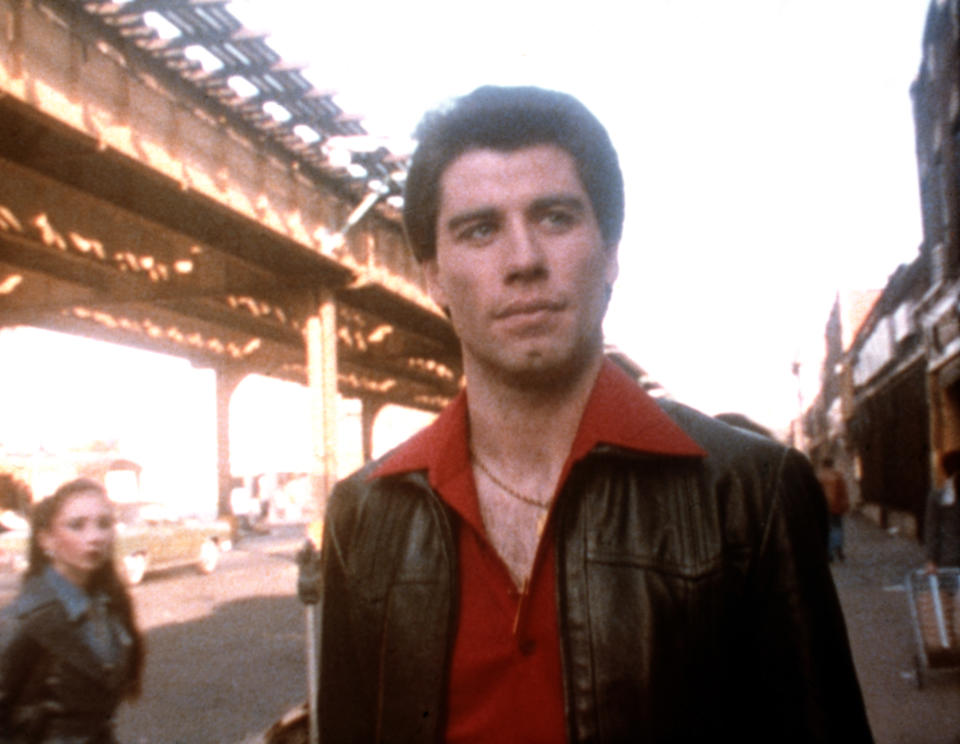You can tell by the way he uses his walk that he’s got no time to talk. Forty five years ago, John Travolta strutted down a Brooklyn sidewalk — and into movie history — in the iconic opening sequence of Saturday Night Fever. Premiering in theaters on Dec. 16, 1977, the disco blockbuster opened by blasting the Bee Gees anthem, “Stayin’ Alive,” and the combination of the band’s music and Travolta’s swagger catapulted the movie into the box office stratosphere.
Believe it or not, though, not everyone was onboard with that choice of song. Saturday Night Fever producer, Robert Stigwood, originally intended to save “Stayin’ Alive” for a dance sequence that comes later in the movie. “He wanted me to dance my big solo dance to ‘Stayin’ Alive,'” Travolta revealed to Yahoo Entertainment during a 2019 Role Recall interview.
Watch our full Role Recall with Travolta below or needle drop to 2:42 for the Saturday Night Fever portion:
[embedded content]
But Travolta knew it would be a mistake to bury the song later in the movie. He just had to find a diplomatic way to help the producer see the error of his ways. “I said, ‘Robert, it doesn’t have a fast enough rhythm [to dance to],'” he remembered telling Stigwood. “But I could walk down the street to ‘Stayin’ Alive.'”
That argument persuaded the producer, and Travolta hit the pavement in character as Brooklyn disco king, Tony Manero, strutting in time to the music. “They played the song on a boombox underneath the camera,” he said, adding that it was the happiest ending possible for the beginning of the Saturday Night Fever phenomenon. “Switching ‘Stayin’ Alive’ to the front of the movie was the best thing that could have been done.”
Speaking with Yahoo Entertainment on the movie’s 40th anniversary in 2017, Fever director John Badham — whose younger sister, Mary, starred in the 1962 classic, To Kill a Mockingbird — agreed that the opening sequence would be DOA with any other song. “The Bee Gees gave me their demo songs, and when I listened to their five demos, I just knew that ‘Stayin’ Alive’ had to open the film,” he explained.
“I also knew that the first thing we should see were Tony’s feet in those very special purple shoes,” Badham continued. “You can tell that his mind is not on his work; it’s on dancing, looking cool, and being a stud out on the street. It puts the focus right away on who the main character is and what’s on his mind. It just happened to come together beautifully like that.”
Saturday Night Fever‘s boisterous opening scene — and the groovy dance numbers — often make people forget that the film itself is actually quite dark and dramatic as it charts Tony’s attempts to flee his working class neighborhood in search of a better future. “The core of it is very dark,” Badham confirmed in his 2017 interview, who added that he approached it as a “documentary of Brooklyn” in the late ’70s, capturing all the violence, economic woes and prejudices of the era.
In the movie’s most notorious scene, Tony’s first dancing partner, Annette (played by Donna Pescow), is raped in the back of his car by his friends, and he doesn’t intervene. “I was kind of reluctant to shoot very much of that scene at all, and kept trying to look for ways to more hint at it,” Badham said. “But Robert Stigwood was very insistent that we do it relatively strongly.”
“What you see is me trying to hint at it without showing too much,” the director explained. “And by playing it a lot off of Annette’s grief and Travolta’s disgust at the whole thing. He doesn’t participate in it, and he’s looking down on those guys who are participating in it, and he’s looking down on her, too. It’s still unpleasant, there’s no getting around that, but it’s important that he sees it all. It’s one other thing that eventually drives him to leave Brooklyn — that and the death of his friend, Bobby, who falls off the Verrazano bridge.”
Badham said that he “did his research” before making Saturday Night Fever, visiting discos all over New York City to create the one seen in the movie. Meanwhile, Travolta took charge of Tony’s look, originally preferring a black suit-and-white shirt combination as opposed to the world-famous white polyester suit everyone remembers. (That suit was later purchased by the late film critic, Gene Siskel, for $2,000. Years later, he sold it for $145,000 at a Christie’s auction.)
But Travolta said that his first choice in fashion was overruled by the movie’s legendary costume designer, Patricia Field. “She insisted that it be a white suit, because you could see it better in the dark,” he recalled. “I actually had to agree — it made a lot of sense. So I acquiesced and thus the iconic illusion that we’re all familiar with was born.” And to this day, it’s still stayin’ alive.
Saturday Night Fever is currently streaming on Paramount+.




